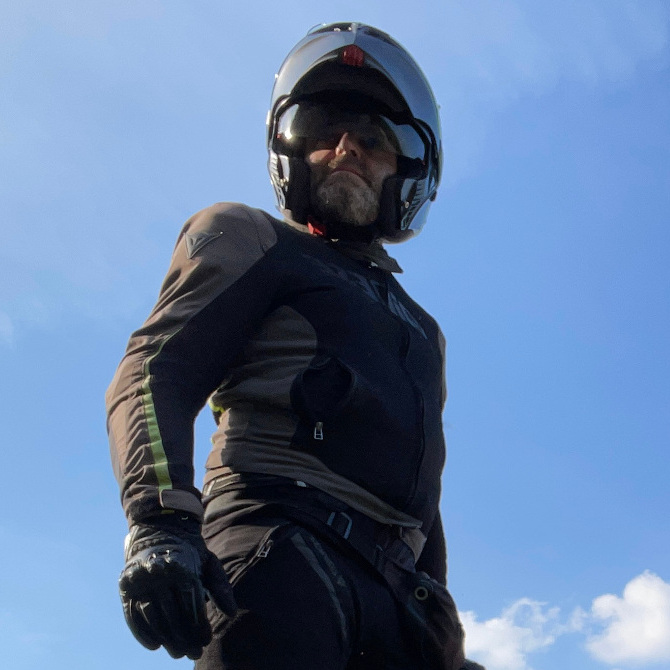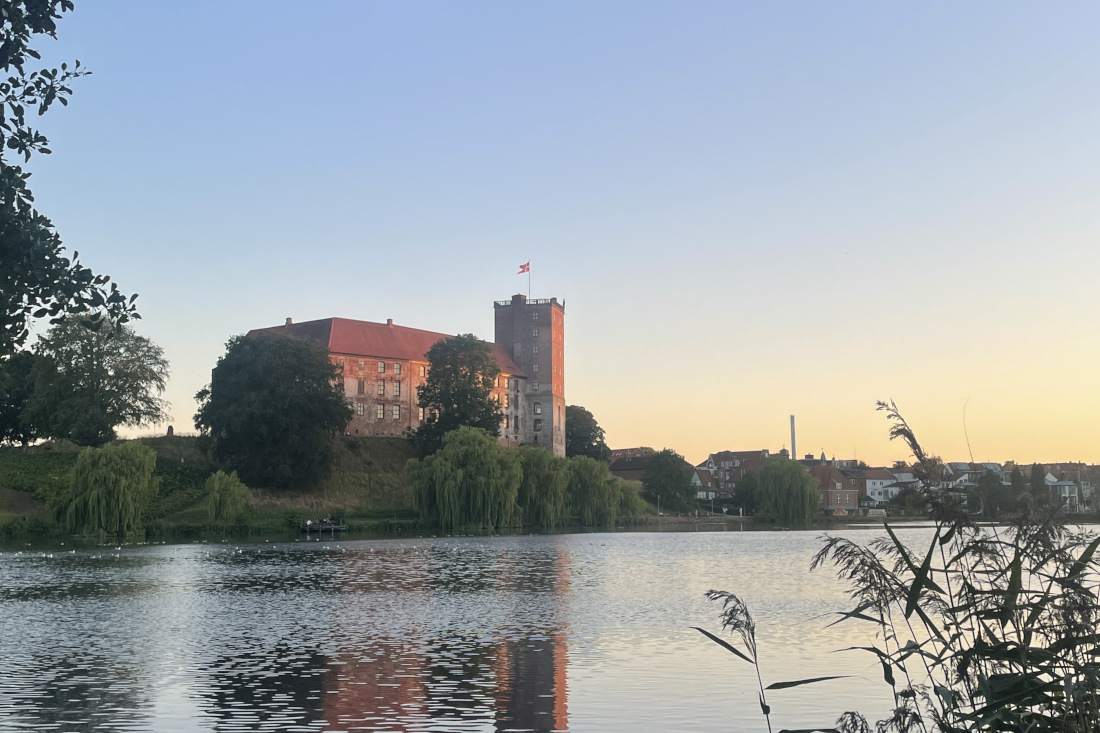
Born in 1976, I work in design and business management. I’m interested in everything that’s Made in Italy, but I’m mostly passionate about motorcycles, travel and photography. I like writing, and for the past five years or so in my spare time I’ve united all my main passions by running a blog about motorcycle routes and rides. My motto is: “I keep an eye on my mirrors, but I never look back.”
With my partner, Claudia, we had already visited Austria and Southern Germany, the Black Forest in particular, by motorcycle. The goal of this new trip was to go further and reach the North Sea, visiting the northern coasts of Denmark and the Netherlands.
Starting from Padua, an itinerary of about 5000 km to reach the maximum latitude of North Jutland.
We chose two cities as our reference points, Kolding in Denmark and Groningen in the Netherlands. Using these two cities as our base camp, we could enjoy days riding our motorcycles free of the weight of luggage.
Having two small saddle bags and a rear bag, with about 90 liters of total capacity, we had to organize our luggage as best we could, having to make this trip as a couple.
I had already traveled to Denmark by motorcycle on my own a few years ago, riding my Ducati Monster 1200, and on that trip I encountered very variable weather, with high summer temperatures alternating with cold rainy days. Based on that past experience, we organized our luggage in such a way that we could withstand both great heat and bad weather with low temperatures.

In particular, I chose this very ventilated basic equipment for me: Dainese Hydra Flux jacket, Dainese Drake Super Air Tex pants, Dainese Air Hero gloves, TCX Firegun Momo Design shoes, Dainese D-Core Dry technical underwear, AGV Sportmodular modular helmet. For colder days I had a Dainese No-Wind jersey and classic rain gear.
My partner Claudia chose this basic equipment: Dainese Hydra Flux Lady jacket, Dainese Fogal gloves, Dainese York Lady shoes, Dainese D-Core Dry technical underwear, full-face helmet. For colder days she had her beloved, faded favorite fleece sweater and a waterproof suit.
We really enjoy walking and experiencing the places we reach on our motorcycles on foot, so we also brought along light summer clothing and suitable shoes for our hikes.
Additional accessories shouldn’t be overlooked either, like a first-aid kit, high-visibility suspenders for riding after dark, a tire repair kit, and a small portable compressor.
On the first two days of the trip we traveled through Austria and Germany, spending the night in a hotel, first in the suburbs of Nuremberg, and then on the second day in the beautiful town of Bispingen, a lovely place, surrounded by greenery, that offers a somewhat special attraction – the upside-down Crazy House, which is really fun to visit.
The third day is when we cross the Danish border and reach our first base camp, Kolding, a port city situated practically in the middle of Denmark, at more or less the same distance from all the places we planned to visit. The afternoon and evening of this third day were then devoted to the beautiful sights of Kolding’s old town and lake.
The fourth day of the trip marks our first stop in the hunt for lighthouses and windmills. We get going with a bang, as they say, visiting Rubjerg Knude Lighthouse. It’s a magical place, with an indescribable charm – high sand dunes, the cliff, the lighthouse rising majestically on the horizon – pure emotion. This lighthouse also has a troubled history and an uncertain future, which I’d invite you to look into and discover. Just minutes away is the picturesque town of Lønstrup, with its classic colorful houses overlooking the North Sea.
The fifth day of the trip is devoted to the Danish capital, which has a surprise up its sleeve to welcome us – it’s really hot, nearly 35 °C, an abnormal temperature for the city even right in the middle of summer. We cross the very long, very high Storebæltsbroen bridge that joins Funen and Zealand, reach the capital, and visit some of the city’s most characteristic sights, starting with the famous Little Mermaid, a must-see, but to be honest not particularly exciting. The spectacular 360° view of the city of Copenhagen that can be enjoyed from the Rundetårn tower is not to be missed, however. Nor is a nice relaxing walk at the old harbor of Nyhavn. Also of interest is Rosenborg Castle, which houses the Danish Crown Jewels. A city like Copenhagen, of course, offers endless other sights and places to visit, but we preferred to end the day enjoying its spirit by walking leisurely and aimlessly through the streets of the center and harbor.
For the sixth day of travel we decide to relax a bit, shortening the daily miles of travel from our base camp in Kolding. Today we go to discover Odense, the hometown of H.C. Andersen, the famous poet and fairy-tale writer, a very pretty and well-kept city that’s full of life. Finally, we continue our hunt by going to visit the Helnæs Fyr lighthouse, which can be reached by driving along a characteristic strip of land south of Funen. This is our last day in Denmark, and we devote the evening to a quiet dinner in the old town of Kolding.
On the seventh day we take it easy, with a long, hearty breakfast, load the luggage back onto the bike, and head for our second base camp, this time in the Netherlands, Groningen.
We spend a quiet evening in our hotel restaurant, unpack and prepare for the next two days.
Today, on day eight, we’ll see a lighthouse and lots of windmills. But first there’s a ‘minor’ setback with the bike. On the highway, we run out of gas. Due to a problem with the fuel light, I don’t notice that I’m all out. With timely support from the local emergency service, we get everything sorted out quickly, but we still have to reorganize and accelerate our planned itinerary. To really understand the meaning of the name “the Nether Lands” there’s nothing better than a walk along the northern coast where the Lange Jaap lighthouse is situated. A very high embankment divides the land from the sea, and the sight of the sea towering over the land in height is really uncanny.
Leaving the shores of the North Sea behind us, we head inland and visit Zaanse Schans, famous for its windmills. The workshops that bring this place to life are another way of delving into the past, and the clog museum in particular is a must.
It’s our ninth and final day as tourists before heading back home. This day is dedicated to the city of Groningen, a vibrant university center, famous for its focus on culture, art, design, and architecture. The whole old town is interesting and packed with little establishments. In particular, the Prinsentuin gardens and the Groninger Museum shouldn’t be missed, but least of all a visit to the Martinitoren, the tallest steeple, with a fantastic view over the whole city.
Finally, to end the day on a high note, we relax with a walk in the brand-new Reitdiephaven Pierwoningen harbor district, which is truly unique and charming.
We spend the tenth and eleventh days of our journey almost entirely on the highway, returning home at a leisurely pace. After ten days of infernal heat (the only cloudy day was in Holland, at Lange Jaap and Zaanse Schans) and temperatures from 25 to 35 °C, we were caught off guard by rain and cold right on the Italian border, at the Brenner Pass.
It was a tiring trip, given the decision to adopt two base camps in Denmark and Holland and travel to our destinations every day, but feasible for anyone, since it means you travel luggage-free every day. It’s an easy itinerary, suited to people who want to mix time riding with dedicating a few hours to strolling through historic old towns and along the coasts of the North Sea.
They’re enchanting and unforgettable locations that make me want to aim even further north next time…